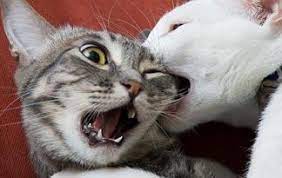Fight scenes in a story or novel need purpose, rising tension and differing camera angles. But wait! There’s more.
Writing Tip for Today: Let’s look at some more features of effective fight scenes.
Use Powerful Verbs & Words
Fight scenes (literal or figurative) shine when you reach into your word bank for the most powerful verbs. If you try to create a scene with general, technical or jargon words, it may be technically correct but probably won’t arouse your readers’ emotions.
Instead use words that evoke what your protagonist perceives as a fight heats up. Verbs such as slam, race, slice or thrust give a less technical but more visual and visceral reader reaction.
Many physical fight scenes bog down when the writer uses too many directional or explanatory words. I know—you’re trying to show readers exactly how a fight unfolds. But when you give directions such as, “He swung around with his right arm and then kicked out with his left foot,” readers get lost trying to decide exactly what that means. Better to write, “He swung around and landed a punch to XX’s gut, then kicked the guy’s chest.”
Keep a Brisk Pace
Whether your fight scene is verbal or physical, pace is essential. In the midst of a fight, your protagonist doesn’t have time for many details. In fact, it’s all happening so fast that some things will be a blur. The background will fade as the character must focus on winning.
One way to ensure a fast pace is to use shorter sentences with few if any multi-syllable words. You don’t want every sentence choppy but if you use more direct verbs and keep at least some sentences short, readers get a feeling of a fast-moving fight.
One reason a fight scene pace is important is to keep readers worried. Readers should worry if the character will overcome the obstacle. Readers’ sense of urgency and panic places the scene squarely in the emotions, which is how you keep readers caring and reading further.
Bring the Emotions Home
Emotions are the key to good fiction and fight scenes often bring out those emotions. But beware: too many fight scenes that use the same moves, the same arguments or the same weapons can become predictable. And predictability snuffs out emotion.

Vary your weapons, your opponents or arguments.
Vary your weapons, opponents or arguments. Allow your character to lose, to fail miserably at times. Give your protagonist a disadvantage of some sort in fight scenes. Change up the environment, even if the goal is the same.
Keep a fight scene firmly rooted in your character’s body. Let readers feel along with that character. This includes feeling pain—either physical, mental or emotional. This is more than saying a character is angry or depressed. If your character is bleeding or he’s injured, let the pain rip through. He can gasp for air or feel a wound throb. If she’s being assaulted verbally or emotionally, let inner thoughts show this psychic pain, and even show how physical symptoms result from a word fight. This is the one place in fight scenes where you can give details that will work to evoke strong reader emotions.






I like that you talk about emotion in this essay. Combat is an emotional experience, often formative. Too many times, I’ve read stories where the author omitted the feelings — physical, mental and emotional.
Hi Eric,
Yep, emotion is what we all must go for in all our work. Readers process a story through their shared experiences and that usually involves strong emotions.
Keep Writing,
Linda